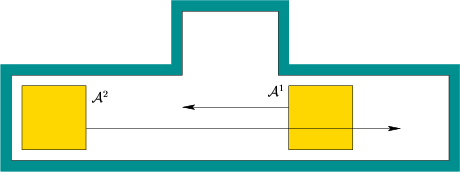
Next: Fixed-path coordination Up: 7.2.2 Decoupled planning Previous: 7.2.2 Decoupled planning
A straightforward approach to decoupled planning is to sort the robots
by priority and plan for higher priority robots first
[320,951]. Lower priority robots plan by viewing the
higher priority robots as moving obstacles. Suppose the robots are
sorted as
![]() ,
, ![]() ,
,
![]() , in which
, in which
![]() has the highest
priority.
has the highest
priority.
Assume that collision-free paths,
![]() , have been computed for
, have been computed for ![]() from
from ![]() to
to ![]() . The
prioritized planning approach proceeds inductively as follows:
. The
prioritized planning approach proceeds inductively as follows:
 |
A special case of prioritized planning is to design all of the paths,
![]() ,
, ![]() ,
, ![]() ,
, ![]() , in the first phase and then
formulate each inductive step as a velocity tuning problem. This
yields a sequence of 2D planning problems that can be solved easily.
This comes at a greater expense, however, because the choices are even
more constrained. The idea of preplanned paths, and even roadmaps,
for all robots independently can lead to a powerful method if the
coordination of the robots is approached more carefully. This is the
next topic.
, in the first phase and then
formulate each inductive step as a velocity tuning problem. This
yields a sequence of 2D planning problems that can be solved easily.
This comes at a greater expense, however, because the choices are even
more constrained. The idea of preplanned paths, and even roadmaps,
for all robots independently can lead to a powerful method if the
coordination of the robots is approached more carefully. This is the
next topic.
Steven M LaValle 2020-08-14